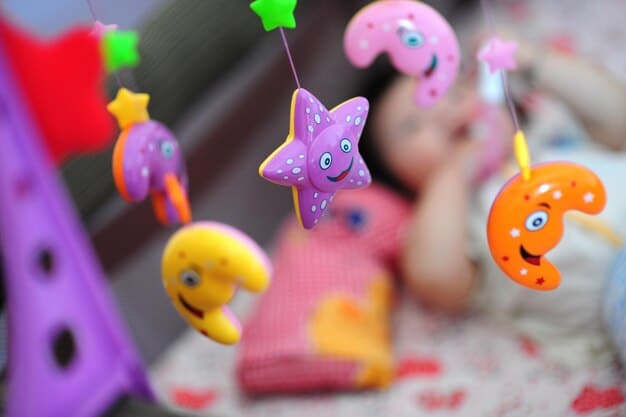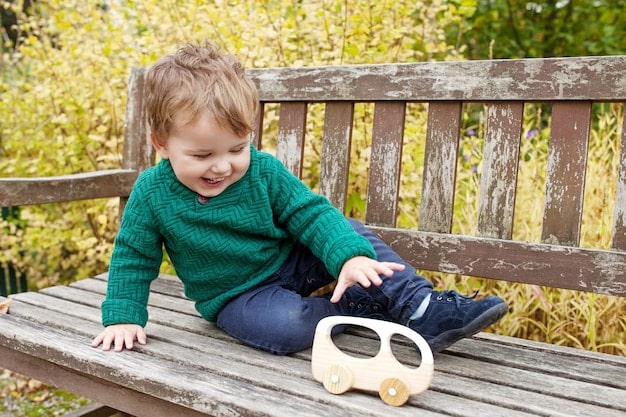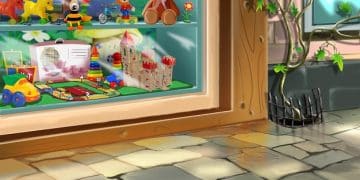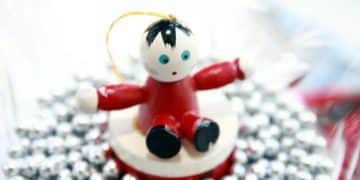The Ultimate Guide to Age-Appropriate Toys: 2025 Expert Picks

The Ultimate Guide to Choosing Age-Appropriate Toys: Expert Recommendations for 2025 ensures children’s safety and development by providing curated toy selections aligned with specific age groups, fostering cognitive, physical, and emotional growth through safe, engaging play.
Navigating the world of toys can be overwhelming, but choosing the right ones for your child’s age is crucial for their development and safety. This comprehensive guide, **The Ultimate Guide to Choosing Age-Appropriate Toys: Expert Recommendations for 2025**, will help you make informed decisions.
Understanding Age-Appropriate Toy Guidelines
Age-appropriate toys are designed to match a child’s developmental stage, abilities, and interests. These guidelines are not arbitrary; they are carefully considered to ensure toys are safe and stimulating for specific age groups. In this section, we’ll break down why these guidelines matter and how they contribute to a child’s growth.
The Importance of Safety
Safety is paramount when selecting toys. Age guidelines help prevent choking hazards, injuries from small parts, and exposure to harmful materials. Manufacturers conduct rigorous testing to ensure their toys meet safety standards for intended age groups.
Developmental Benefits
Age-appropriate toys also offer significant developmental benefits. They encourage cognitive skills, fine motor skills, problem-solving abilities, and social interaction. Choosing toys aligned with a child’s developmental stage ensures they are challenged but not overwhelmed.
- Cognitive Development: Toys can stimulate thinking, memory, and reasoning skills.
- Physical Development: Active toys promote gross motor skills and coordination.
- Social-Emotional Development: Toys can foster empathy, cooperation, and communication.
Ultimately, understanding age-appropriate toy guidelines is the first step in creating a safe and enriching play environment for your child. By prioritizing safety and developmental benefits, you can select toys that will support their growth and spark their imagination.
Infants (0-12 Months): Stimulating Senses
During the first year, babies are rapidly developing their senses and motor skills. Toys for this age group should be safe, visually stimulating, and easy to grasp. Let’s explore some great options to support their early development.

Safe and Soft Toys
Infants explore the world through their mouths, so toys must be free from small parts and non-toxic materials. Soft plush toys, rattles, and teethers are excellent choices for this age group.
Visual and Auditory Stimulation
High-contrast colors and gentle sounds can capture a baby’s attention and stimulate their developing senses. Mobiles, musical toys, and textured balls are ideal for sensory exploration.
- Mobiles: Enhance visual tracking and focus.
- Rattles: Develop auditory awareness and hand-eye coordination.
- Teethers: Soothe sore gums and explore textures.
Choosing toys that cater to an infant’s sensory exploration is crucial for their early development. Prioritize safety and select options that stimulate their senses and encourage motor skills.
Toddlers (1-3 Years): Encouraging Exploration
Toddlers are energetic explorers eager to learn about the world around them. Toys for this age group should encourage creativity, problem-solving, and physical activity. In this section, we’ll discuss the best toy options to support their growing independence.
Building Blocks and Shape Sorters
These classic toys help toddlers develop fine motor skills, hand-eye coordination, and spatial reasoning. Look for large, chunky blocks and shape sorters that are easy for small hands to manipulate.
Push and Pull Toys
Push and pull toys encourage toddlers to move and explore their environment. Wagons, strollers, and pull-along animals promote gross motor skills and coordination.

- Building Blocks: Foster creativity and spatial reasoning.
- Shape Sorters: Enhance problem-solving and hand-eye coordination.
- Push Toys: Improve balance and gross motor skills.
Selecting toys that encourage exploration and creativity is essential for toddler development. Choose options that support their growing independence and provide opportunities for physical activity and problem-solving.
Preschoolers (3-5 Years): Fostering Imagination
Preschoolers have vivid imaginations and are eager to engage in pretend play. Toys for this age group should encourage creativity, social interaction, and problem-solving. Let’s explore the best options to foster their imaginative minds.
Dress-Up Clothes and Role-Play Sets
Dress-up clothes, dollhouses, and play kitchens allow preschoolers to explore different roles and scenarios. These toys encourage social interaction, communication, and creative expression.
Art Supplies
Crayons, markers, paint, and modeling clay provide preschoolers with opportunities to express themselves and develop fine motor skills. Art supplies foster creativity, self-expression, and hand-eye coordination.
- Dress-Up Clothes: Encourage role-playing and social interaction.
- Art Supplies: Foster creativity and fine motor skills.
- Puzzles: Enhance problem-solving and spatial reasoning.
Creating opportunities for imaginative play is vital for preschooler development. Choose toys that encourage creativity, social interaction, and problem-solving to support their growing minds.
School-Aged Children (6-12 Years): Developing Skills
School-aged children are developing more complex skills and interests. Toys for this age group should challenge their minds, encourage teamwork, and promote problem-solving abilities. In this section, we’ll discuss the best toy options to support their academic and social growth.
Board Games and Card Games
Board games and card games foster critical thinking, strategic planning, and social interaction. These games encourage teamwork, communication, and problem-solving skills.
Science and Building Kits
Science and building kits provide hands-on learning experiences that encourage curiosity and problem-solving. These kits allow children to explore scientific concepts and develop engineering skills.
- Board Games: Enhance strategic thinking and social interaction.
- Science Kits: Foster curiosity and hands-on learning.
- Building Kits: Develop engineering skills and problem-solving abilities.
Selecting toys that challenge their minds and encourage teamwork is essential for school-aged children. Choose options that support their academic and social growth, fostering critical thinking and problem-solving skills.
Teenagers (13+ Years): Engaging Interests
Teenagers have diverse interests and seek toys that reflect their growing independence and maturity. Toys for this age group should engage their minds, encourage creativity, and provide opportunities for social interaction. Let’s explore the best options to support their evolving interests.
Strategy Games and Puzzles
Strategy games and complex puzzles challenge teenagers’ critical thinking skills and provide hours of engaging entertainment. These games encourage problem-solving, strategic planning, and mental acuity.
Creative Arts and Crafts
Art supplies, craft kits, and musical instruments allow teenagers to express themselves and explore their creative talents. These activities foster self-expression, creativity, and artistic development.
- Strategy Games: Enhance critical thinking and problem-solving skills.
- Creative Arts: Foster self-expression and artistic development.
- Technology Gadgets: Encourage exploration and innovation.
Engaging teenagers’ diverse interests is key to selecting age-appropriate toys. Choose options that encourage creativity, problem-solving, and social interaction to support their growing independence and maturity.
Expert Tips for Toy Safety and Maintenance
Ensuring toy safety and proper maintenance is crucial for protecting children and extending the lifespan of toys. In this section, we’ll share expert tips to help you keep toys safe, clean, and well-maintained.
Regular Inspections
Inspect toys regularly for damage, loose parts, or sharp edges. Repair or discard damaged toys to prevent injuries. Regular inspections help identify potential hazards before they become a problem.
Cleaning and Sanitizing
Clean and sanitize toys frequently to prevent the spread of germs, especially toys that are handled by multiple children. Use non-toxic cleaners and follow manufacturer’s instructions for proper cleaning.
- Inspect Regularly: Check for damage and loose parts.
- Clean Frequently: Sanitize to prevent the spread of germs.
- Store Properly: Keep toys organized and protected.
Following these expert tips for toy safety and maintenance will help you create a safe and healthy play environment for children. Prioritize regular inspections, proper cleaning, and organized storage to ensure toys remain safe and enjoyable for years to come.
| Key Point | Brief Description |
|---|---|
| 👶 Infant Toys | Focus on stimulating senses with safe, soft toys. |
| 🧸 Toddler Toys | Encourage exploration with blocks and push toys. |
| 🖍️ Preschooler Toys | Foster imagination with dress-up and art supplies. |
| 🧩 School-Aged Toys | Develop skills with games and science kits. |
Frequently Asked Questions
▼
Age ranges ensure toys are safe and developmentally appropriate. They prevent hazards like small parts for infants and challenge a child’s cognitive abilities without overwhelming them.
▼
Look for toys made of non-toxic materials, with no small parts that could be a choking hazard. Soft, plush toys and simple rattles are great choices for infants.
▼
Building blocks, shape sorters, and push-and-pull toys are excellent for toddlers. These toys help develop fine and gross motor skills, problem-solving, and spatial reasoning.
▼
Provide dress-up clothes, art supplies like crayons and paint, and role-play sets like play kitchens. These toys encourage imagination, social interaction, and self-expression.
▼
Board games, science kits, and building kits are ideal. They enhance strategic thinking, teamwork, problem-solving, and curiosity, supporting academic and social growth.
Conclusion
Choosing age-appropriate toys is a vital aspect of supporting children’s development and ensuring their safety. By following expert recommendations and considering each age group’s specific needs and interests, you can provide a stimulating and enriching play environment that fosters cognitive, physical, and emotional growth. Prioritize safety, encourage creativity, and select toys that challenge and inspire children at every stage of their development.





